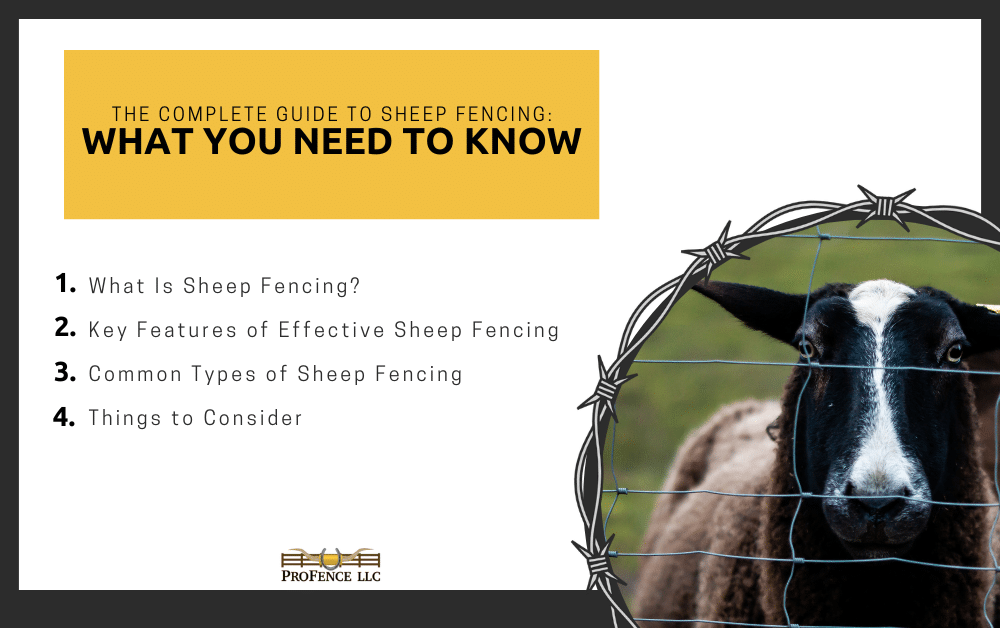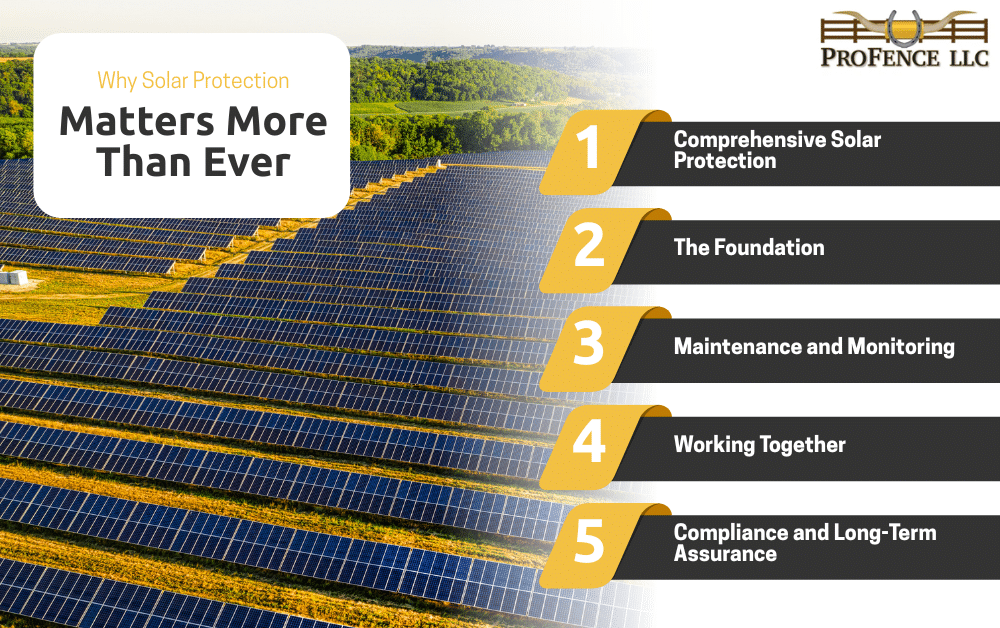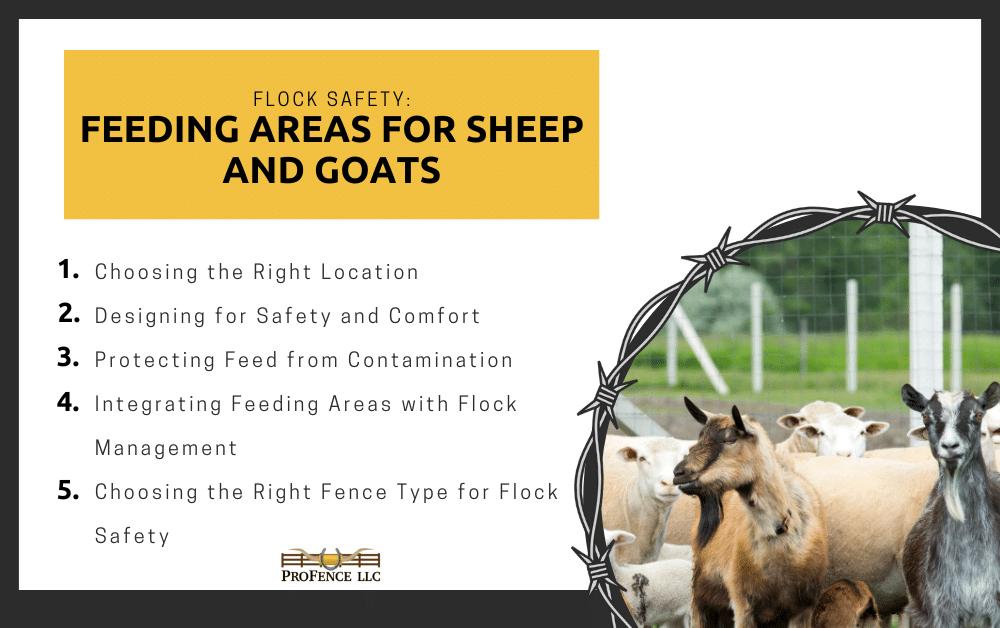Keeping livestock safe and contained is a critical responsibility for any landowner, farmer, or homesteader. At ProFence, we recognize that sheep require specific fencing solutions tailored to their behavior, size, and environmental vulnerabilities. A well-constructed fence does more than mark boundaries—it keeps your flock safe from predators, prevents costly escapes, and helps simplify pasture management. Whether you’re raising sheep for wool, meat, breeding, or as part of a regenerative grazing system, the proper fencing can make all the difference. This guide explores the essential elements of sheep fencing, offering practical advice to help you protect your animals and your investment.
What Is Sheep Fencing?
Designed Specifically for Sheep Behavior
Sheep fencing is built to address the unique tendencies of sheep, which differ significantly from those of other livestock. Sheep are persistent and curious—they will test weak points in a fence, especially if there’s food on the other side. They are also prone to slipping through wide gaps or attempting to climb unstable materials. Therefore, sheep fencing must be specifically designed to contain them without causing harm or stress. A properly installed fence accounts for these traits by using tight spacing, smooth materials, and sturdy construction that prevents sheep from escaping or becoming entangled.
Additionally, sheep have a strong flocking instinct. When one sheep attempts to push through a weak fence line, others are likely to follow. This group behavior increases the likelihood of large-scale escapes or injuries if the fencing isn’t suited to their needs. That’s why it’s not enough to repurpose fencing intended for cattle or goats—sheep fencing must be engineered with the animal’s natural behaviors in mind.
Protection Against Predators
One of the most critical roles of sheep fencing is protection from predators. Sheep, and especially lambs, are vulnerable to a wide range of threats, including coyotes, foxes, wild dogs, and even domestic pets. Unlike some livestock, sheep have limited means of self-defense, making a secure perimeter essential. A predator-proof fence often includes electrified wires, buried components to prevent digging, and a proper height to deter jumping animals.
Predator activity is often heaviest at night, meaning your fencing must do its job even when you’re not around. Installing high-quality fencing reduces the need for nighttime surveillance or costly security systems. It also gives you peace of mind knowing your flock is safe, especially during lambing season when ewes and young lambs are most vulnerable.
Durable and Long-Lasting Solutions
Longevity is a primary consideration when investing in sheep fencing. Your fencing system must endure exposure to wind, rain, snow, and temperature fluctuations while standing up to the daily wear-and-tear caused by the animals themselves. Materials such as galvanized steel, high-tensile wire, or treated wooden posts offer durability that withstands the elements and physical stress.
A well-constructed fence should last 15–20 years or more with proper maintenance. Choosing quality over cost-cutting upfront can save you from constant repairs, replacement materials, and downtime later. Long-term durability also helps reduce operational disruptions, ensuring your farm functions smoothly year-round.
Key Features of Effective Sheep Fencing
Proper Height and Gap Size
Sheep are not natural jumpers, but they can scale fences if they’re too low or improperly constructed. For most breeds, a fence height of 3 to 4 feet is sufficient. However, the genuine concern is often the spacing between wires or mesh openings. Young lambs, in particular, can slip through gaps in standard fencing if the mesh is too large.
Practical sheep fencing features tighter spacing near the bottom to block lambs, while allowing for increased spacing higher up to reduce material costs and improve visibility. This combination maintains a strong barrier without obstructing the view across fields or pastures. Fencing with graduated spacing is especially effective for mixed-age flocks.
Materials That Prevent Injury
Safety should always be a top priority when selecting materials. Barbed wire is not recommended for sheep, as it can easily snag wool and tear skin, leading to infections and unnecessary veterinary costs. Instead, smooth wire or woven wire mesh offers a firm, visible barrier without sharp edges or points.
Injury prevention not only protects your animals but also safeguards your profits, particularly if you’re raising sheep for wool or breeding. Damaged fleece can reduce market value, and frequent injuries may lower productivity. Choosing the right materials helps maintain herd health and minimizes downtime due to avoidable accidents.
Sturdy Posts and Electric Enhancements
Fence stability starts with the posts. Wood or metal posts should be set deep enough to withstand pressure from sheep rubbing or leaning. In areas with soft soil or freeze-thaw cycles, reinforced posts or concrete footings may be necessary. Most fencing systems require post spacing of 8 to 12 feet, adjusted as needed for terrain or fence material.
Adding a low-voltage electric wire along the interior of the fence line is a smart way to discourage sheep from testing the boundary. This is especially useful in high-pressure areas such as gates, corners, or feeding zones. Electric wires can be solar-powered in remote regions and adjusted for safe contact with livestock. These enhancements help reduce physical damage to the fence, extending its usable life.
Common Types of Sheep Fencing
Woven Wire Fencing (Field Fencing)
Woven wire fencing is one of the most popular and dependable options for containing sheep. It features closely spaced horizontal and vertical wires, often with a graduated design that offers tighter gaps at the bottom. This makes it highly effective at containing both adult sheep and lambs.
For added security, many farmers install a single electric strand along the top or bottom of the woven fence. This discourages climbing and deters predators that may attempt to dig or climb. While the initial cost of woven wire is higher than some alternatives, its strength and longevity make it a cost-effective solution in the long run. It’s especially recommended for permanent pasture fencing or perimeter enclosures.
Electric Net Fencing
Electric net fencing is an excellent choice for rotational grazing, temporary paddocks, or small-scale sheep operations. Lightweight and portable, netting can be installed quickly and moved as needed to fresh pasture. This allows for better pasture utilization and soil regeneration through planned movement of the flock.
However, electric net fencing requires regular maintenance to stay effective. Vegetation growing around the netting can short out the current, and the fence must remain tensioned and powered at all times. It’s ideal for shepherds who want flexibility and quick deployment, but not as a long-term, predator-proof solution.
High-Tensile Electric Fencing
High-tensile electric fencing is suited for large pastures and commercial sheep operations where permanent fencing is needed across long distances. It uses tensioned steel wires combined with electrical pulses to create a psychological barrier that sheep learn to respect.
This type of fencing is relatively low-cost per foot, but it requires proper installation and grounding to function effectively. Sheep must also be trained to recognize and avoid the fence. With careful planning and regular checks, high-tensile fencing is a powerful, long-term solution for farms with expansive acreage or challenging terrain.
Things to Consider
Adapting to Terrain and Climate
Your fence must match the unique features of your property. Hilly or uneven land may cause gaps beneath fencing, requiring you to contour the fence line or add more anchor points. Rocky terrain can make post installation more challenging, requiring specialized tools or alternate post materials.
Climate also plays a significant role. In wet areas, galvanized or coated materials are essential to prevent rust and corrosion. In windy locations, bracing and post depth become more critical. Designing your fence to suit your specific landscape ensures better performance and fewer repairs down the line.
Managing Predators and Environmental Risks
If your area has known predator activity, you’ll need to reinforce your fencing accordingly. This may include deeper posts, top and bottom electric strands, or buried fencing to block animals that dig. In extreme cases, double fencing or even livestock guardian animals may be used in conjunction with physical barriers.
Environmental challenges such as flooding, snowdrifts, or wildfire risk should also factor into your fence planning. For example, elevated fencing might be necessary in flood-prone areas, while fire-resistant materials could be critical in dry climates. Consider your local risks and choose solutions that protect your animals year-round.
Ongoing Maintenance and Cost Planning
Every fence system requires regular inspection and maintenance. Electric fences should be tested weekly for voltage levels and checked for vegetation interference. Physical fences need routine tightening, replacement of damaged posts, and monitoring for wear.
When budgeting, look beyond the initial installation cost. Consider labor, equipment, future repairs, and time spent on upkeep. A Higher initial spending on top-quality materials and professional installation often leads to fewer problems and lower costs in the long run. Strategic planning ensures you stay on budget while maintaining reliable protection for your flock.
Choose ProFence for Reliable Sheep Fencing Solutions
At ProFence, we understand that every property and livestock operation is different. That’s why we offer customized fencing solutions tailored to your land, climate, and management style. Our team brings decades of expertise in agricultural fencing and will work closely with you to design a system that meets your goals.
We use premium materials, proven construction techniques, and thoughtful layouts to ensure your fencing stands the test of time. Whether you need permanent perimeter fencing, temporary solutions, or predator-proof barriers, we have the experience and tools to get it done right. Our commitment to quality and service means you’ll get a fence that performs reliably season after season.
Contact ProFence today to schedule a consultation or request a quote. Protect your sheep with a fencing solution that works as hard as you do—built for safety, durability, and peace of mind.







